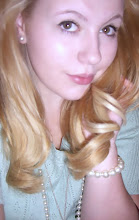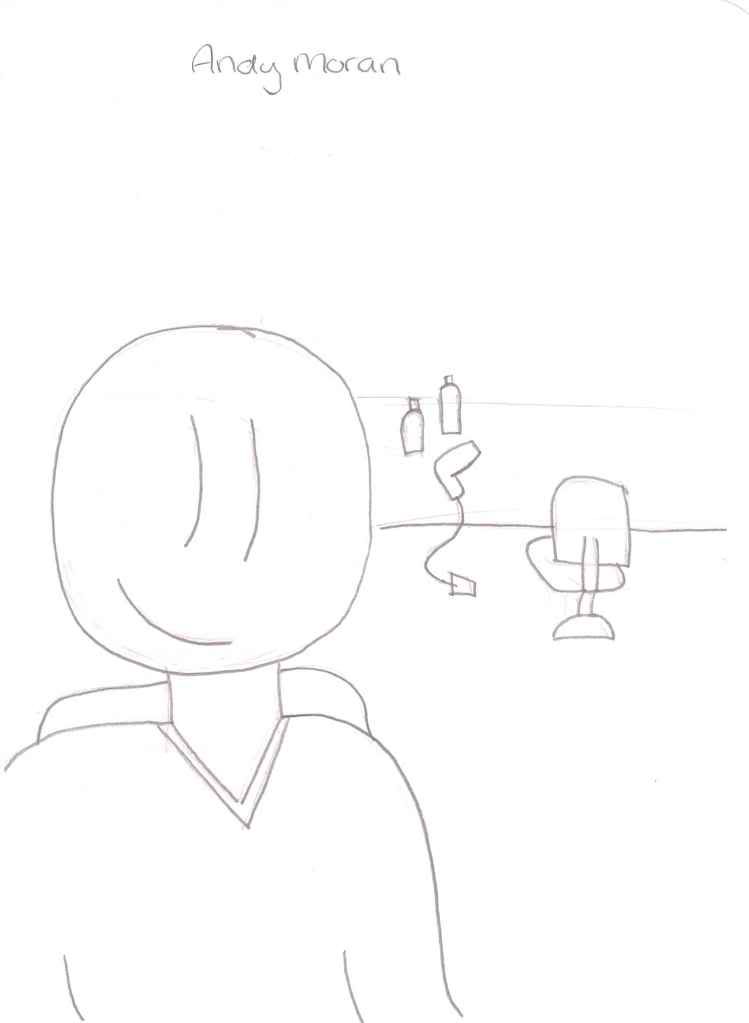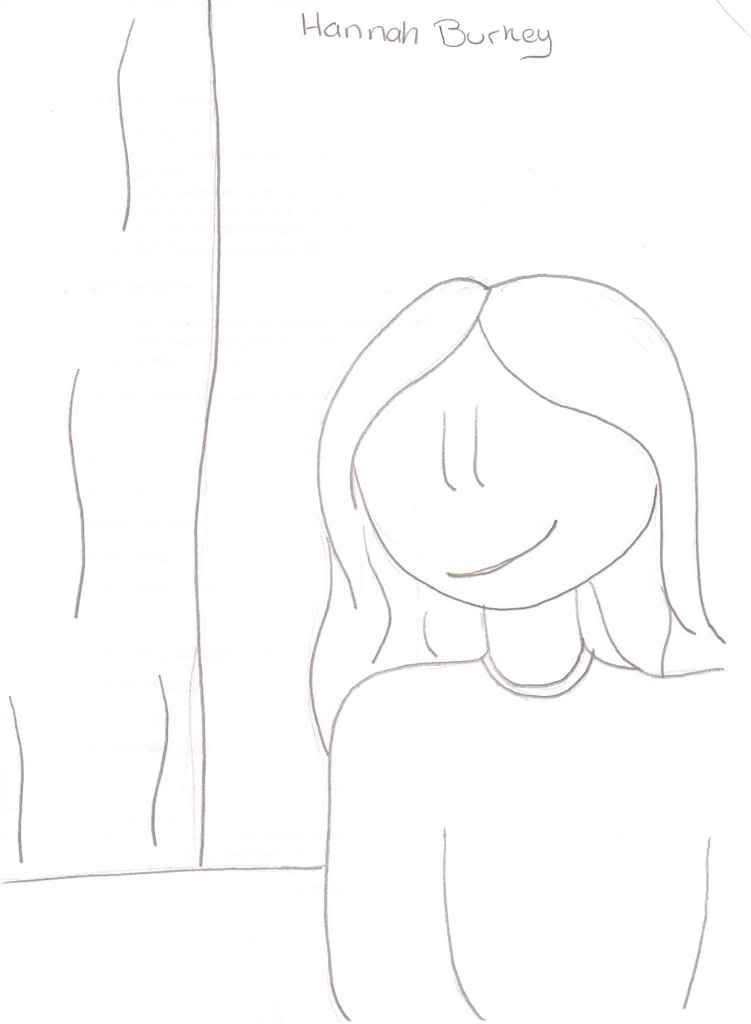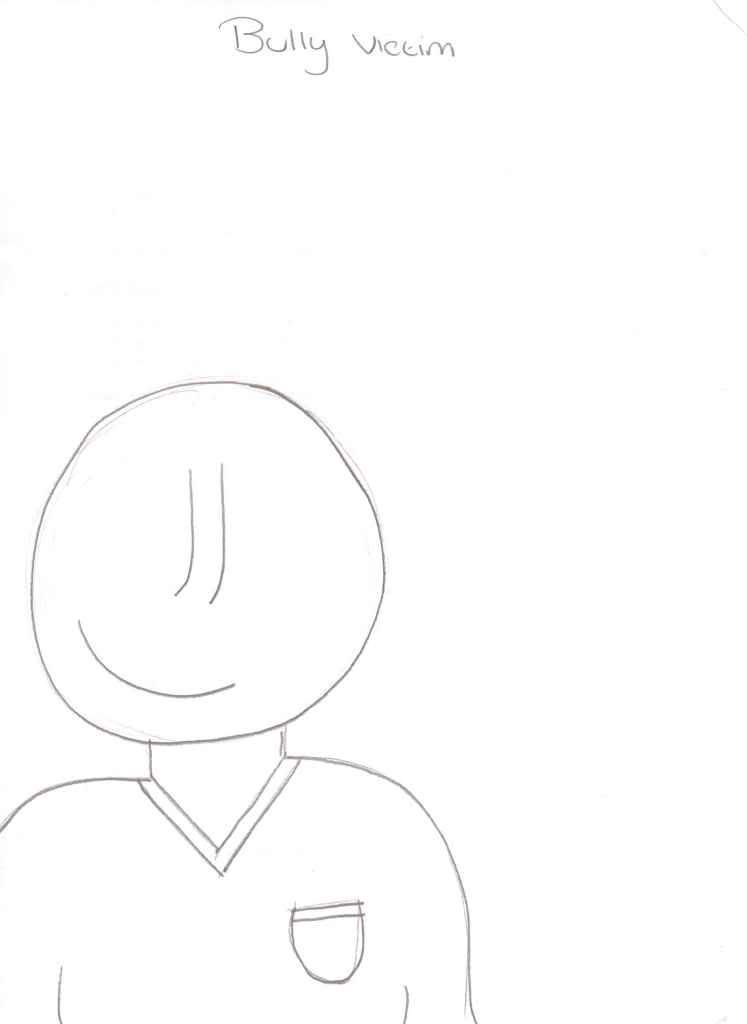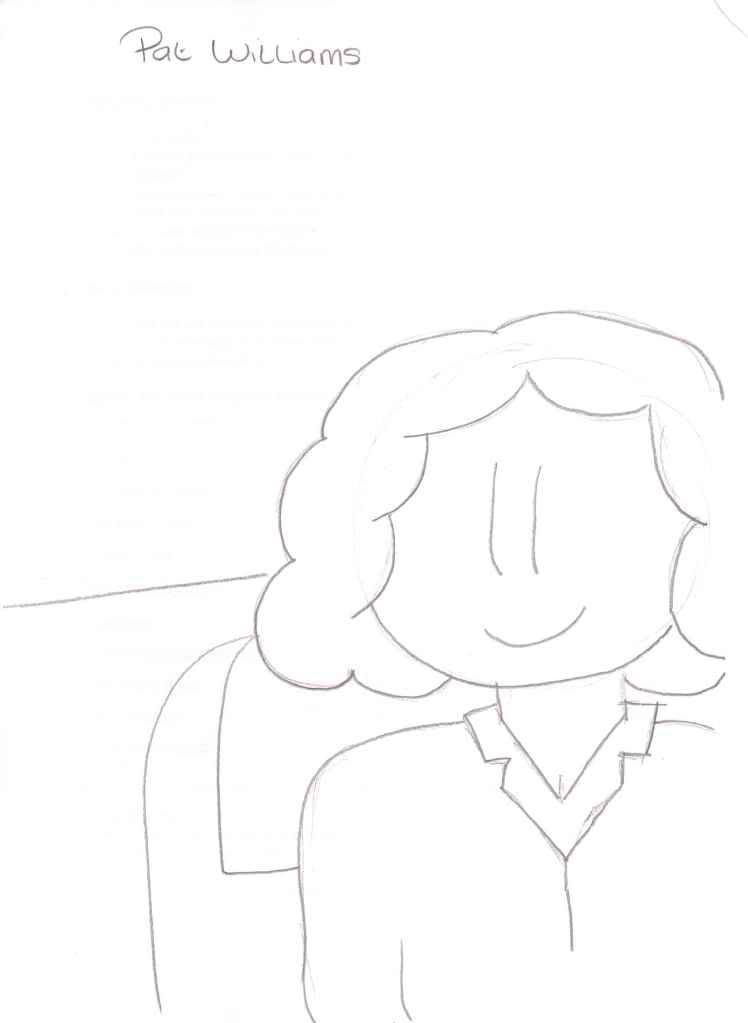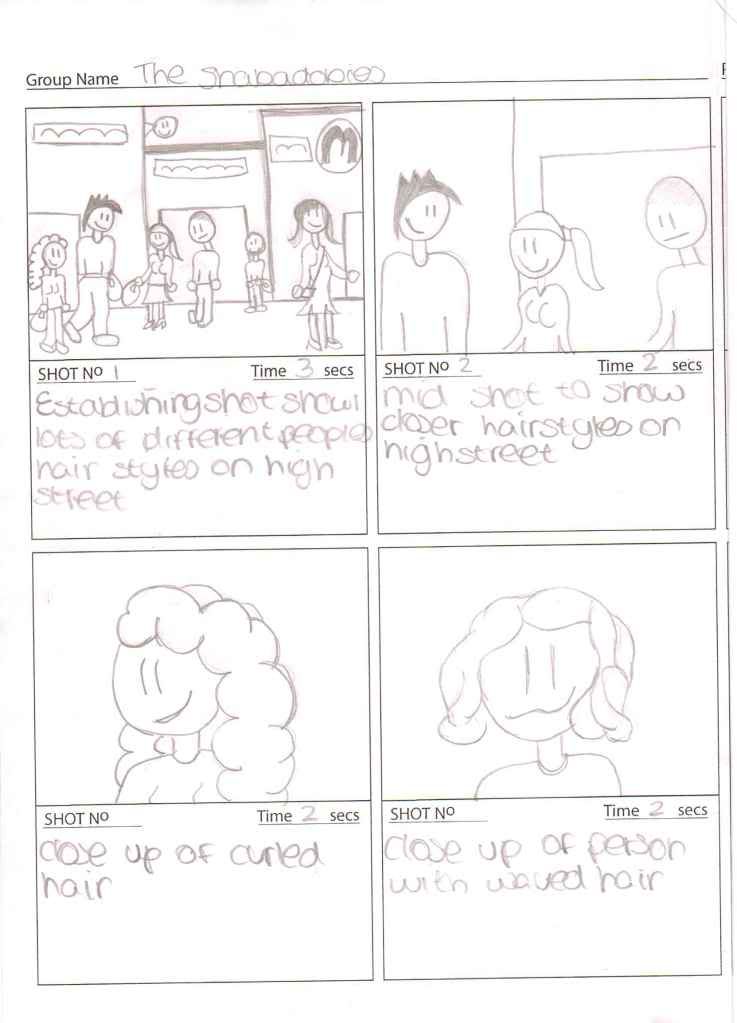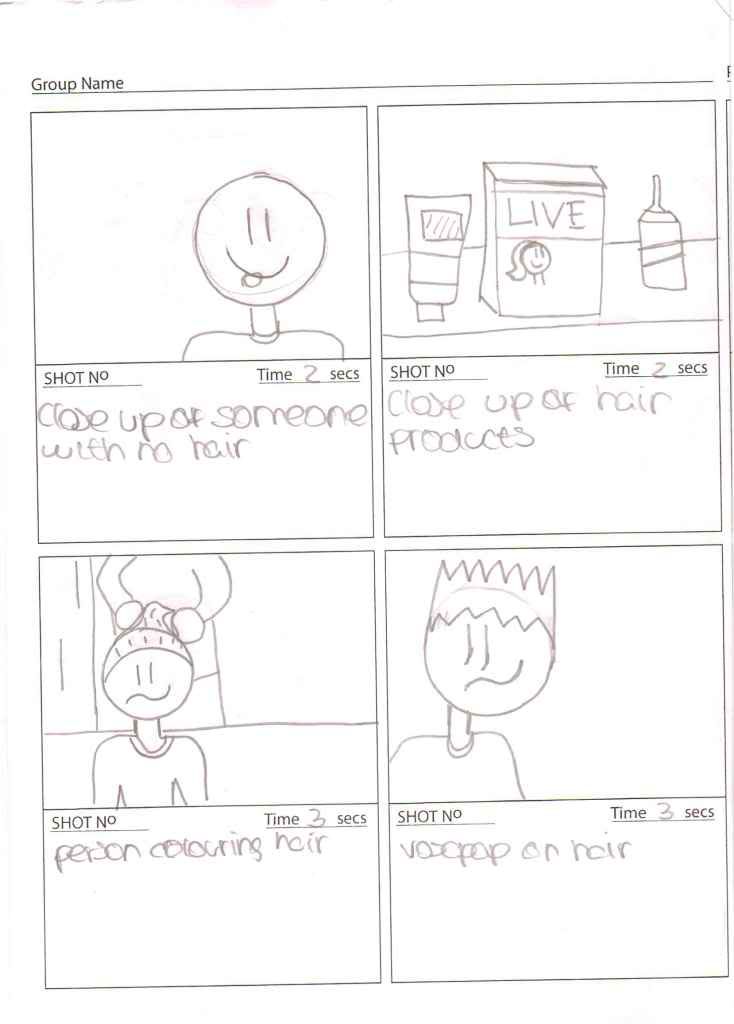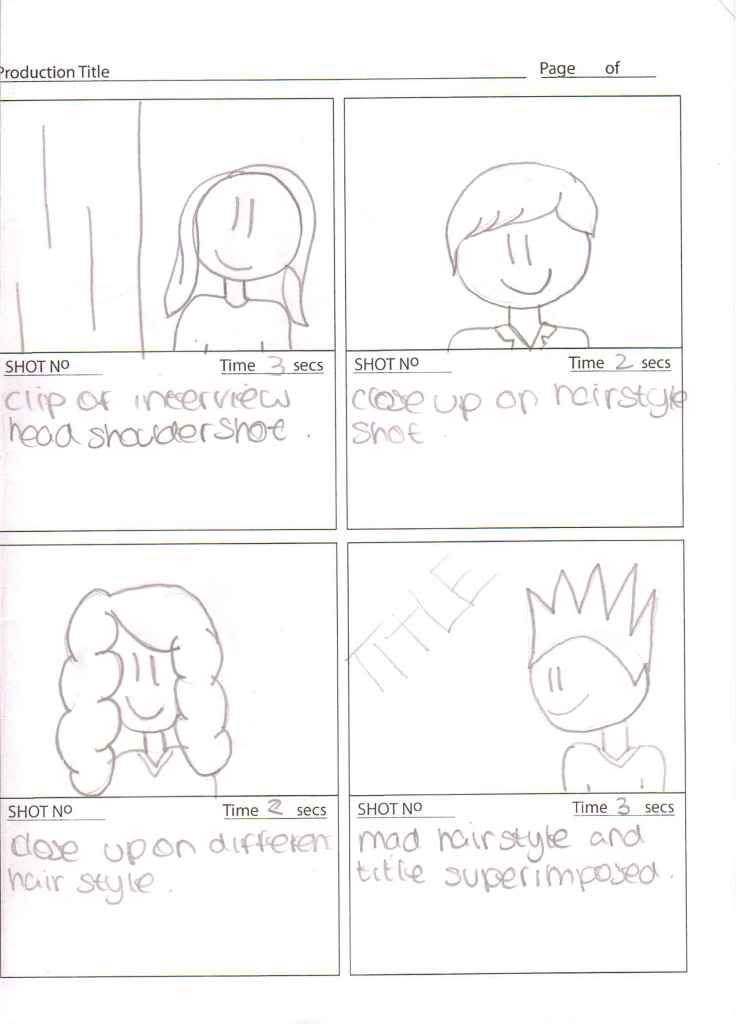Thursday, 16 December 2010
EVALUATION
In what ways does your media product use, develop or challenge forms and conventions of real media products?
There are many codes and conventions to consider when creating media products. Documentaries tend to follow a trend that I have tried to recreate in my own documentary about hair. One of the first things that we c
onsidered when creating this documentary was looking at the people we would film for our interview and the relevant cutaways that we would use in the film. This is as one of the obvious trends in a documentary is the fact that they all will have experts talking about the topic the documentary is based on and they all have cutaways that are also relevant to this topic. We developed and challenged this convention by having more complex and creative cutaways that include exciting editing techniques on the different hair related shops on the high street and camera angles when focusing on the different hair products within hair shops.
One of the key codes and conventions that we have included in our documentary is that all of the interviewers are looking away from the camera. This meant that if any of the interviewees looked at the camera during filming we had to retake the shoot. This allowed us to expand on this convention and make it better with repetition. Also within the interview process of the documentary a convention is that you never hear the question that the interviewer poses meaning that they are edited out during the editing process. This gives the effect that the interview is more natural and runs smoother. It is trend to have the graphics at the bottom of the screen to show the audience the main information that is relevant about the person being interviewed. We developed this idea by having our graphics in the same colour that we found out in our audience research was the majority of people’s favourite colour. These are shown with in the first few seconds of the person being on screen and the time they are shown never exceeds five seconds. The framing within the interview is also key, as if this doesn’t match the codes and conventions then the interview has to be re-filmed in the correct framing, otherwise it is uncomfortable for the audience to watch the interview comfortably.
As well as cutaways being relevant to the documentary the background and mise-en-scene of the interview also has to be relevant. We used this in our documentary by creating a background with different pictures of people’s hair on it to go in the background of the person being interviewed. This is as it anchors meaning to the documentary and ensures that the audience member it always being reminded what that documentary is about. We developed this convention by interviewing a barber in front of a mirror, showing the reflection of the shop and the tools the barber uses in the background; I feel this was very effective. The only time within the documentary were the background in an interview is usually not relevant is during the vox pops, and that is because these interviews are conducted at random on the street. Another convention that we used in our interviews is that the interviewee is either looking to the left or the right. We challenged this convention by mixing the position of the head between interviews. This created more diversity.


My media product here shows how it is very similar to real media products through following the codes and conventions of print adverts. This shows here that our print advert looks very similar to the ones of a professional standard through following some easy things. Firstly the image we chose was simple yet had an impact on the audience and told them exactly what the documentary was about but in a way that makes them want to watch the documentary to find out more. This is what both print adverts do. Also you will notice that we have used the channel four i-dent in the same place as on the real advert. This keeps to the conventions of print ads and gives the advert an overall more professional look. Also the titles are the same colour as the i-dent. This is a subtle code of print adverts that we have included to make the product look even better and realistic. The information we have given on the advert is also relevant and in relation to the type of information that you would usually expect to see on a print advert. The image on both print adverts have also been manipulated in some way or edited to make it have a stronger impact on the viewer. This makes the product look of a very high standard.
The radio advert below is an example of a professional one that is currently being used/ has been used in the media. When played in comparison to mine you will see that both radio adverts follow the same codes and conventions to make them look professional and interest anyone that is listening. Firstly the music bed used interests and attracts the audience to listening, and then the voice over artist has an interesting voice in some way that makes you interested in what they are saying. It also uses some sort of slogan to tell the audience member what the product is and make you think about what is being played. This makes our radio advert look as though it is a professional one.
I realize that this is not an advert for a documentary. But they are hard to find on the internet and this clip demonstrates the codes and conventions of a radio trailer.
QUESTION TWO
QUESTION THREE
To gather information of what people thought about my documentary I posted the video on my Facebook profile and asked them to comment on what they thought. This is the information we gathered;



Laura comments on the framing of the interview with the barber making the documentary look professional. This is goodas it means that it is meeting the needs of the viewer. She also states that she enjoyed the documentary and it looks well made.

Helen says here that we have used relevant music in the music bed to keep the meaning anchored to the documentary topic. Helen also gives positive feed back about the opening title sequence and says that it is ‘funny’ showing that we also are entertaining the audience as well as informing them. She also says that it looks ‘professional’ suggesting that she didn’t see any visible problems with editing or cuts.
 David has given me some mixed feed back; he states that the cutaways and music are relevant and fit well with the flow of the documentary. But David also states that a woman is in the shot of the interview that doesn’t speak. This is a problem we noticed, unfortunately it was a two shot interview, but this woman didn’t say anything during filming. We still used the footage though as we felt there was still useful information in the footage and it gave a variety of interview framings throughout the documentary.
David has given me some mixed feed back; he states that the cutaways and music are relevant and fit well with the flow of the documentary. But David also states that a woman is in the shot of the interview that doesn’t speak. This is a problem we noticed, unfortunately it was a two shot interview, but this woman didn’t say anything during filming. We still used the footage though as we felt there was still useful information in the footage and it gave a variety of interview framings throughout the documentary.

Rachel says firstly that she enjoyed the documentary which is positive feedback. She also comments on the sped up archived footage of the man shaving head, this is good as it was used as a transition to one topic about hair to another. She also mentions that she enjoyed the reconstruction as the added drama to the documentary. This is good as modern documentaries are more and more dramatized, which means we meet the codes and conventions of modern documentaries.
GROUP FEEDBACK
It is important for a documentary to be informative but also entertaining at the same time. This ensures that the documentary will be watched all the way through and people are more likely to watch more documentaries if they are enjoyable. This is why this question is
important as it ensures that people are enjoying the documentary otherwise if they didn’t enjoy it they wouldn’t watch it. This is a good result that we have gathered, this positive feedback tells me that 14/15 people enjoyed the documentary meaning that it was a success in this way. However one person did say that they didn’t enjoy the documentary.
This could be due to this result. This result shows that one person didn’t think that the editing was smooth so this could be the reason there was one person that didn’t enjoy the documentary. This problem with editing could be due to two things. From the facebook comments it looks like there could have been a problem with how fast the cuts are, as this is the only thing that could be seen as making the editing look un-smooth. This feedback is also positive though, as it shows that most people feel the editing was smooth. The continuity of a documentary has to be good, as this ensures that the documentary is easy and enjoyable to watch. Good continuity is a convention of documentaries, showing that my documentary meets the requirements of a documentary.
FURTHER FEEDBACK
Hannah here in the video states that she feels that the documentary worked well. She says that she thinks the opening title sequence is fun and enjoyable making her want to watch the rest of the documentary. This is good as this is one of the codes and conventions of a documentary that the first opening titles have to make the viewer want to carry on watching. However, she says that she didn’t think that the interview with the two wig shop owners fit in with the documentary as it didn’t have the same upbeat feel as the other interviews. This is understandable but may just be down to personal reference, as the documentary had to include this bit about hair too fit with the slogan ‘highlights and low lights’ i.e. the good and bad things about hair.
When questioned on the about her thoughts on the radio advert, Hannah states that she felt the advert made her want to watch the documentary because it sounded so fun and upbeat. This is good because it shows that we used correct codes and conventions of relating the music bed to the documentary and drawing in the audience. On the other hand, she says that the music jumped at one point, this is as we wished for the part of the song ‘that weirdo with five colours in her hair’ to be played at this point and it could have been a problem with the editing process.
Feedback about the print advert was great as it showed that we succeeded in creating a print that looked professional and made people want to watch the documentary.
IN SUMATION
In hindsight this feedback helped me see that the people that viewed my media products did actual enjoy them, and although there were some problems with the media, they were there for reasons and could be explained as to why they were there. Overall I feel that the feedback was positive.
QUESTION FOUR
EVALUATION QUESTION FOUR on Prezi
If prezi doesn't work on blogger, click the link above and watch it on the website.
AUDIENCE FEEDBACK
PRINT ADVERT
Is it clear the documentary is about hair?
Is the information given relevant?
Does it catch your attention and make you want to watch the documentary?
RADIO ADVERT
Do you think that the narration is relevant?
Did you enjoy the documentary?
Was the editing smooth?
DOCUMENTARY
Do you feel the titles were appropriate?
Did the opening title sequence make you want to watch the documentary?
Did you feel the documentary, radio and print adverts worked well together?





RADIO ADVERT SCRIPT
Highlights and lowlights. Hair! Long hair, short hair. Big hair, no hair. Red, blue, yellow, green.
what do people really think of young people’s hair today? Regardless of individuality are stereotypes the same as they’ve always been?
IT’S HAIRMAZING.
On yer ‘ed, channel four, Thursday at 8pm, be there or be hair!
RADIO ADVERT CODES AND CONVENTIONS
Radio adverts are another way to attract the audience to watch your documentary. Just like the print advert had to be eye-catching the radio has to be ear-catching. This means those following codes and conventions, these are;
· What channel and time it will be on.
· Sound clips from the programme.
· A voice over.
· Gives an insight to what the show is about.
· Occasionally there is a music bed included.
I realize that this is not a radio advert for a documentary, but it is hard to find one on the internet. But i have still used this clip, as it demonstrates the requirements of a radio trailer.
PRINT ADVERT CODES AND CONVENTIONS / PLANNING
 When creating a print advert for a documentary it is important to look at the codes and conventions of real print adverts in everyday life. Firstly the print advert is always landscape. This means that it can be published in a newspaper or if necessary can be placed on a billboard and is the perfect size to do so. The print advert usually consists of one large image standing on its own. This image has to be eye-catching and tell the viewer what the documentary is about. Over this image is the ident of the channel logo of which the documentary is going to be shown on. This is placed on the right of the screen in the middle. Information is also placed on the print advert; this tells the viewer the name, date shown, and slogan of the documentary. The graphics on the print advert is usually simple and match those used in the documentary someway to relate the two products.
When creating a print advert for a documentary it is important to look at the codes and conventions of real print adverts in everyday life. Firstly the print advert is always landscape. This means that it can be published in a newspaper or if necessary can be placed on a billboard and is the perfect size to do so. The print advert usually consists of one large image standing on its own. This image has to be eye-catching and tell the viewer what the documentary is about. Over this image is the ident of the channel logo of which the documentary is going to be shown on. This is placed on the right of the screen in the middle. Information is also placed on the print advert; this tells the viewer the name, date shown, and slogan of the documentary. The graphics on the print advert is usually simple and match those used in the documentary someway to relate the two products. 

Monday, 15 November 2010
FILMING/ DIARY/ PICTURES
Today we interviewed a female hairdresser Nicky Lambert. We interviewed her as we decided to interview both a male and a female hairdresser to get differing opinions. We interviewed Nicky to gain information on the hairdressing industry and the different and popular hairstyles of today. The interview went well; good framing with no problems at all. However mise en scene could have been better.
4/10/10
Today we interviewed wig makers and asked them questions on reasons for wigs, who buy wigs and what wigs are made of. We found this to be interesting for our topic as it ties in well with hair. The interview was good although awkward as two people were involved; regardless the framing was good and was an overall success.
18/10/2010.
Today we interviewed Pat Williams. We interviewed her because we felt it would be good to find out how hair styles have changed over the last few decades and what older people think of younger peoples hair nowadays. However, this interview wasn't a success as the framing wasn't as good as it could be and the answers weren't exactly what we were looking for as they didn't include a lot of information.
28/10/2010.
Today we filmed our Vox Pops. We went to the Wicked Cafe in college and asked fellow students how they felt about hair nowadays to gain knowledge on how students look at other peoples hair styles. Apart from one person we interviewed, all the vox pops we filmed are usable.
29/10/2010.
Today we filmed more Vox Pops. We went to Warrington Town Centre, gained permission to film that day and then asked members of the public if they would mind answering a few questions. We did this because we wanted to get a number of people who are different ages opinions on hair today. This was the second time filming vox pops as the first time we had incorrect framing. We also filmed our reconstruction of David being bullied. This was successful as we got some good footage that can be used.



1/11/2010.
Today we went to Runcorn to film Hannah Burkey - a person who has recently dyed their hair for the first time - and David Edger who was bullied during his school years due to his hair style and colour. We wanted to interview Hannah because we felt it would be good to find out how dying your hair can affect and change how you act and what people think of you, and we wanted to interview David to find out how hair stereotypes can be taken too far and how it can affect someone in a negative way. These interviews were successful as all answers that were given were what we were looking for and the framing was good.
5/11/2010.
Today we went into Stockton Heath to film our cutaways and interview a barber at the "Original Barber Shop". We filmed cutaways of hair products inside and outside many hairdressers and stores after gaining permission and then interviewed the barber. We did this because we wanted to look into what a professional thinks about hair styles nowadays.

7/11/2010.
Today we filmed and captured more cutaways such as TV footage and music videos and cutaways of our Mise-en-scene used in some of our interviews.
8/11/2010.
Today we began to capture and edit all our footage.


12/11/2010.
Today we came into college when it was a day off to get more editing done and make sure we had all footage captured.

14/11/2010.
Today we interviewed Jackie Williams, we were originally planning to re-interview Pat, unfortunatley she was unavailable at the time we needed to film. However, when interviewing Jackie we got some much better answers and the framing was good this time, although the mise-en-scene could have been better.
Thursday, 7 October 2010
PLANNING
INTERVIEW WTH HAIRDRESSER
INTERVIEW WITH PERSON DYING HAIR
INTERVIEW WITH PERSON WHO WAS BULLIED
INTERVIEW WITH OLD PERSON
OPENING SEQUENCE
INTERVIEWS
We have 3 interviewees who we are going to include in our documentary.
The first is Hannah Burkey who is dying her hair for the first time. We will interview her about how she is feeling about dying her hair permanently for the first time and will ask her how it is before, during and after so we can see how people think it will affect their lives.
We will then interview Andy Moran, of Callaghan & Moran Hairdressers in
We will finally interview Patricia Williams, asking her what hair styles she's had throughout her life, what she thinks of young peoples hair today, and how it differs from when she was our age. We will also ask questions regarding how often she gets her hair coloured and cut etc.
INTERVIEW QUESTIONS
HANNAH
Before
Have you dyed your hair permanently before?
Why haven't you dyed it before?
What colour are you dying your hair?
Are you excited to do it
How do you think it will effect your life?
Do you think you're ready to dye your hair?
During
How do you feel?
Is it what you expected?
How do you think the colour will turn out?
Do you think your friends will like it?
After
Do you think it looks good?
Does it look how you expected it to?
Would you dye your hair again?
Are you worried about what everyone will think?
Was it fun to dye your hair?
ANDY
How long have you been a hairdresser for?
Do you enjoy your job?
What age range of customers do you work with most?
What are you opinions on young peoples hair nowadays?
What is the 'craziest' hair style and colour you've had to do for someone?
What is the 'craziest' hair style and colour you've had yourself?
Do you agree with stereotypes? If so, which ones?
Would you ever not hire someone based on their hairstyle?
How many people who get their hair cut have their hair dyed too each day?
Are there any hair styles that a lot of people ask for?
Which celebrities hair style do people ask for most?
Are there any celebrities that inspire you because of their hair?
What is the most popular hair dye colour?
PAT
How many different hair styles have you had?
Were the hairstyles you had popular at the time?
What colours have you dyed your hair?
How much time do you spend doing your hair?
Do you enjoy doing your hair?
How long does it take to get your hair cut and coloured?
Do ypu enjoy getting it cut?
Do you change the style of your hair a lot? If so, how often?
Do you have a particular celebrity whose hair you base yours off?
What do you think of young people’s hair today and how do the styles differ from the hairstyles you had at that age?
Have you ever judged someone based on their hair style and colour?
VOX POPS
1. What is the first thing that comes to your mind when you hear blonde?
2. What is the first thing that comes to your mind when you hear brunette?
3. What is the first thing that comes to your mind when you hear ginger?
4. What is your natural hair colour?
5. Who is your hair icon?
6. What is the craziest thing you’ve done with your hair?
7. Is your hair naturally curly or straight?
8. What do you think of young people’s hair today?
RUNNING ORDER
RESEARCH
For out Primary Research Ww looked at who we could interview and we found a local hair dresser in Warrington who was willing to be interviewed, as well as people with different hair styles and colours to talk to us about stereotypes and how they;re treated. We looked for locations to shoot and for our reconstruction we thought a park would be the most suitable location and for the interviews, we decided when interviewing the hairdresser to do it either in the hair salon, or set up a relevant background if that isn't possible due to noise etc. Props we thought we could use are hair care products like shampoo and conditioner, as well as having gel, wax, a hair dryer and straigteners in the background. For other interviews, we thought it would be best to film the interview in a comfortable environment for the interviewee, so they don't feel intimidated, for example, if we film infront of a blue screen or projection.
For secondary research, we looked at archive material such as videos, images, music, surveys and articles. We also looked at celebrities who prove their stereotypes wrong and prove that you can b
 e successful with what could be classed as 'socially unacceptable'.
e successful with what could be classed as 'socially unacceptable'.
A celebrity we thought that beats their stereotype is Vanessa Feltz.

We also thought about a celebrity who had a 'socially unacceptable' hair style, and we thought P!nk
was a good example and she is a very popular musician.We looked into music we could use in our documentary and we thought "Five colours in her hair" by McFly was a good choice as it is relevant to the subject.
However, we will download an mp3 of the song to use.
We then looked into archive footage we could use to anchor the points made throughout and we found a video on YouTube, showing how badly stereotypes and bullying because of hair colour can affect people in a negative way.
A marketwire survey we found showed that 40% of the men surveyed worried about hair loss, this can be found here. We also found an article that looks into the blonde stereotype here.
HISTORY OF HAIR
(60’s – 00’s)
THE SIXTIES
In the 1960’s hair always had a great deal of work to get it to the right look the person wanted. Curls were all the rage in the 60’s whether they were big deep curls, small tight curls and even spit curls. Hippies of course Prided themselves on the defiance of style.
Longer, straight hairstyles are seen in 60’s programmes although they were not the norm. These were more commonly seen on younger people in the 60’s rather than older people.
The picture to the right was more commonly seen in the long hair look, long and wavy, free swinging hair.
In the 1960’s Vidal Sassoon and twiggy had a very big influence on shorter hairstyles, they were the stimulus for a whole new view of hair styling. Named the "The Face of 1966" supermodel Twiggy sported an ultrashort hairdo which was compatible with her boyish figure.
The Bouffant is the word that describes all the poofy hair styles. The big hair of the Sixties required that hair expanded out from the head. This was accomplished by setting with rollers the size of Coke cans.
THE SEVENTIES
During the 1970s, personal expression was the key to a great hair style. Groovy looks explored personal values and individuality rather than society's expectations, and both men and women embraced more natural styles with longer locks less tamed by hair products. Funky looks were also popular, particularly for trendy, younger individuals, and offered another way to express a person’s personality. Many 1970s hairstyles are in vogue today because they are classically appealing, particularly for anyone interested in a stylish natural look they can care for and maintain easily. This says that 70’s hairstyles are coming back into today’s society as they had big hair with lots of products although easy to maintain.
THE EIGHTIES
In the 1980’s everybody wanted to be a rockstar or at least wanted to look like one, hats and super straight hair was popular, however for the younger people side ponytails were all the rage. 1980’s was time for punk, being a big influence for the “emo” scene now, mohawks and big, big hair was popular for both males and females. Untamed curly hair and creative braiding was also a familiar sight to see in the 80’s. Other removable hair styles were popular in the 1980’s. For celebrities; short hair and stunning afros were popular and were also popular with the mainstream public. The most popular look was just basic cropped and choppy hair.
THE NINTIES
Hairstyles of the 1990’s for women were heavily influenced by Rachel from the T.V. show friends. Having a shoulder-length, sleek and layered style with a grown out fringe and highlights mainly around the face.was all the rage in the 90’s for a lot of women. This was called the “Rachel cut”. In the 1990’s hair changed rapidly throughout the year from having a dirty blonde and choppy hair, through to a thin bob influenced by the character lois from superman. This hairstyle was then taken and changed by posh spice and was changed into a smaller and heavier bob which a lot of women had copied. As it was for the women of the 90’s movies and music had a heavy influence on male hairstyles, actors from keanu reeves to joey from friends and in music from mc hammer to vanilla ice. The 90’s media was the main influence for hairstyles and have had a big effect from the 90’s until now. Zig Zags and nike ticks were a popular style in the 90’s with most teens as these were seen in a lot of rap music at the time
Wednesday, 6 October 2010
FORMAL PROPOSAL AND PRODUCTION SCHEDULE
TOPIC
The topic we chose to create a documentary based on was Hair. This is as it is easily accessible and is a broad subject, meaning that it gives us many possible stories we can follow through the documentary. This topic also means that we can question many of the public as all people have hair and opinions on what style is fashionable. Interviews will also be easier to arrange within this topic as there are many hairdressers around.
TYPE
The type of documentary we have chosen to make our documentary is mixed. This is as this is the type of documentary we have researched and means that we can use a broad range of techniques within our documentary to show case our work and make the documentary more interesting.
STYLE
We have chosen to make our documentary informal as this means it will be more accessible to the type of audience we wish to broad cast to. Informal documentaries also tend to be more modern and fun; this will attract more people to watch.
CHANNEL AND SCHEDULING
Channel 4 is the channel we have chosen to display our documentary on as this is a channel we think our target audience is more likely to watch at about 9 0’clock before a popular television programme, the ‘Inbetweeners’.
TARGET AUDIENCE
Our documentary is aimed mainly at 16-25 year olds who are our target audience. We are targeting this age range as hair has a big impact on fashion and the majority of fashion conscious people are aged 16-25. These 16-25 year are also mainly students which gives us good ideas of what channels we should put our documentary on.
PRIMARY RESEARCH
For our primary research we created a questionnaire to give to people to fill in asking a variety of questions that would help choose the audience we want to make this documentary appeal to most. We included questions like what gender they are, so we know who to make the documentary appeal to most. We asked what their favourite genre of TV show is as well as their favourite TV show, so we gained an idea of what people enjoy to watch and could think about airing the documentary before a popular programme. We asked at what time of the day they watch TV most so we knew what time would be best to air our documentary. We also asked how many documentaries they normally watch and if they enjoyed them so we could find out if we would have to really try to gain peoples interest if they don't enjoy documentaries or if a lot of people enjoy watching a documentary. We then asked what their favourite colours were, so we could use colours that would appeal to a wider audience to gain their attention and we asked what their favourite genre of documentary is, to gain an idea of how big the audience will be, and how many more people we need to get interested. All of those questions were asked so we could find the best time to air our documentary, whereas we then began ask questions about peoples hairstyles, colours, if they have dyed their hair, how often they go to the hairdressers so we could find out if our target audience would most importantly enjoy the documentary we are trying to persuade them to watch and all the answers we received are shown above in the audience research section.
We then began to look into who we could interview, such as hairdressers and people who spend a lot of time sorting their hair out as it means a lot to them how it looks. We then looked into the locations we could film which we decided would be near or in a hairdressers and when interviewing we would make sure the mise-en-scene is relevant to the subject, by again, interviewing in a hairdressers, or in an environment in which the interviewee is comfortable. We thought about what props we could use and we found that this would be quite basic as the props we need are ones to do with hair styling such as, dye, brushes, straighteners and hair dryers, as well as the equipment used in the hair salons.
SECONDARY RESEARCH
NARRATIVE STRUCTURE
Beginning - The beginning of the documentary will involve stereotypes of different hairstyles and colours and will also show bullying that goes on due to hair. A reconstruction will be shown at this point. The beginning will also give information about hair and give a few of the different hairstyles there are and show different hair colours people have.
Middle - the middle of the documentary will involve hair dressers opinions on hair and their experiences. We will show these opinions through interviews where they will also tell us about the crazy hairstyles they have encountered. The middle will also include some archive footage of things like the “Gingers don’t have souls” video from youtube, and also music videos to show a change in hair through the years of music.
End - the end of the documentary will resolve the conflicts and say it doesn’t matter about what hairstyle you have or what hair colour you have, and will tell us how it shows individuality explaining the good points about different hairstyles. There will be shots of celebrities at this point showing their different hairstyles.
OUTLINE OF CONTENT
In our documentary we are going to have an opening sequence in which we have pictures of lots of different peoples hairstyles with McFlys “5 Colours in her hair” playing and then after that we will have the voice over introducing our documentary and talking over more images and possibly a mid-shot of someone getting their haircut. The voice over will explain how hairstyles have changed over the years, what hair styles and colours are socially acceptable and will then ask why. We will include an interview with a hairdresser, asking them their opinions on certain hair styles and colours and ask how many people have their hair coloured and if they have noticed any similar personalities and/or stereotypes between people with the same natural hair colour e.g. blonde girls being dumb and during this interview we will include cutaways which are relevant to what is being spoken about. We can also ask them about stereotypes and if they believe in any of them and we will then cut to a reconstruction of a red headed person being bullied because of their hair colour for example, maybe a group of people surrounding them and calling them names. We will have another voice over explaining that people put hair colours and styles into stereotypes without realised and we will have vox pops of what first comes to a persons mind when they hear a certain hair colour. We will use archive footage of a YouTube video where a teenager is discussing how he is discriminated because he has red hair. The voice over will then go on to tell us how it's not just hair styles people worry about and then tell us that an online survey has shown that 40% of men are worried about losing their hair, we will also include cutaways of balding/bald men as this is spoken about and will then look into the stereotype that bald men are far more stressed than men who haven't lost their hair.
We will also include more of the the interview of the hairdressercontinuing a similar subject as before but also including details about which hairstyles and colours are more socially acceptable. We will then include vox pops of what the public think of young peoples hair nowadays and then who is their 'celebrity hair icon'. We will cutaway to archive footage of celebrities as they are mentioned. We will include more archive footage of celebrities as the voice over discusses which celebrities have been successful despite having hairstyles which may not be considered 'socially acceptable' to some, such as P!nk the singer and celebrities that have proven a stereotype wrong, for example Vanessa Feltz being a smart, blonde haired woman, proving the 'dumb' stereotype wrong.
RESOURCE REQUIREMENTS
We will need specific resources. The most obvious of resources we needed was a camera and microphone. We used these firstly to film our vox pops and to record peoples answers by voice to our questionnaires. Which brings me to our next requirements; our questionnaires. We needed the questionnaires for audience research to see what our audience want to see in a documentary. We also needed the general public as a resource so we have people to film and gain vox pops from. A hairdresser is important also for our resources as we need to interview a hairdresser and gain some detailed answers making the hairdresser a very important resource for our documentary. One of the most important resources is the internet. The internet is where we will gain our archive footage and where we will gain the most information about hair, and the history of hair and its styles of the past 60 years
PRODUCTION SCHEDULE
Name Of Programme: On ya’ ed
Directors: Jessica Healey, Joe Williams, Matt Price
Producers: Jessica Healey, Joe Williams, Matt Price
Client: OCR
Date production Started: 27th September
Formal Proposal Started: 4th October Completed: 11th October
Storyboard Started: 8th October Completed:
Shooting Started: 11th October Completed: 1st November
Post Production Started: Completed:
Rough Cut Submitted: 15th November
Final show tape completed: 22nd November
Sent To Client: 17th December
Location Equipment Required:
Camera, Digital camera, Tripod, Microphone, Headphones.
Transport Required:
Local buses and own provided transport
